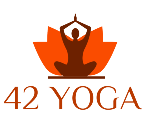I know you’re out there! You have been told you *should* do yoga, perhaps by your doctor, a friend concerned about how stressed you are, or your own inner voice, but you just don’t want to do it! It’s okay, you’ve come to the right place. Plus, as self-development guru Tony Robbins would say: “Stop ‘should-ing’ all over yourself!”
It’s no use starting yoga if you don’t want to do it. I guarantee you won’t continue doing it, even if you drag yourself along to one class. The negative emotions, for a start, will mean you won’t get any positive benefits.
I know when you are thinking of yoga, you are thinking of the yoga poses (or perhaps the impossibly bendy women on Instagram doing poses next to waterfalls.)
However, I have some good news, if this is the yoga you don’t like, you can easily make yoga something you DO like, and get all the benefits in the process.
My biggest tip is to make up your own moves instead of trying to force yourself to do ‘yoga poses’. One big theory is that the yoga poses came from Scandinavian gymnastics originally anyway. (Read this article for insight.) Also, one of the ancient texts of yoga, Patanjali’s Yoga Sutras, only mentions physical postures in three out of 196 sutras. The focus of the sutras is more on removing the fluctuations of the mind, reaching oneness with the divine (exiting duality), and guidelines for right way of living. So, go on, make up your own moves, and don’t worry about it not being ‘pure’ yoga.)
The yoga poses (asana) are only one of the eight limbs of yoga, so if you don’t like them, there are 7 other limbs you can focus on.
This tip is a great replacement for the poses, for a start. This is something you can do on your own at home. Just play some positive music you like that lifts your spirits, and do some (safe) ‘dancing’/movement to that music. Move with conscious awareness of the breath and sensations in the body. Move with focus on sensations in the body. Try moving intuitively and without force. To incorporate more ‘yoga’ you want to let go of striving, or judgment of yourself, or expectations, and focus on being in the moment, with an intention to nourish yourself. Don’t think about what you look like or what anyone would think if they saw you. Don’t look in a mirror. Be free!
Yoga movement is useful for getting rid of stagnant energy by moving energy around the body, and if you do your own version of yoga like the above, you will definitely be doing that.
One of the key things about yoga is being in the moment and it’s going to be easier to be in the moment, and even get lost in the moment if you are enjoying the movement. Maybe you’ll find you do like ‘Yoga’, because you are there, in the moment with some high-vibration emotions from dancing to music you actually like. If you can generate the good feelings, that will keep you coming back to this practice.
You can set a timer using your phone’s timer or the Insight Timer app’s timer is a good one. Then you don’t have to think about the time.
Other beneficial Yoga practices you can incorporate
Breathwork
Breathwork is a powerful, life-changing practice from yoga. You can incorporate breathwork into your day by stopping, and taking even one big diaphragmatic breath.
Try learning one or more of the transformational yoga breathwork practices. Alternate nostril breathing, for example, will give you a delicious feeling of calm, balance and harmony. The feeling alone will keep you coming back to practise this. Even if you just do it for a minute, you will feel a change in your body and state of mind.
Legs Up the Wall
This is known as yoga’s magic pose, and what do you have to do? That’s right, all you have to do is put your legs up the wall! It is useful for when you can’t sleep, mild anxiety and mild headaches. Team it with some deep conscious breath and witness the magic!
Yoga Nidra
If you haven’t heard of Yoga Nidra, you are going to love this one. Yoga Nidra is a deep relaxation and guided meditation technique that allows for deep rest and rejuvenation. It’s a practice where one lies down comfortably and follows verbal instructions, making it accessible to those who may not enjoy physical postures. Yes, you are just lying down the whole time!
The practice of stillness is also very beneficial and Yoga Nidra can allow you to let go of all the busyness of life and see what it’s like to be still.
Get on the Insight Timer app and look up Yoga Nidra to find some free guided sessions.
Mindfulness
Integrate mindfulness into daily life by bringing awareness to everyday activities like walking, eating, or simply being present in the moment. Walking in nature is a wonderful practice for every day. Mindfulness encourages a state of awareness without judgment.
Yoga Philosophy and Study
This won’t be for everyone, but if you love self-development and history, you could explore the philosophical and historical aspects of yoga, learning about its principles, ethical guidelines (Yamas and Niyamas), and ancient texts like the Yoga Sutras of Patanjali. Engaging in intellectual study can offer a deeper understanding of yoga beyond the physical aspects.
Yoga for the Mind and Emotions
Focus on practices that enhance emotional well-being, such as gratitude journaling, self-reflection, or journaling about one’s thoughts and feelings. These practices can foster a sense of self-awareness and inner peace.
Sound Therapy (Nada Yoga)
Explore sound healing or Nada Yoga through practices like listening to calming music, chanting mantras, or attending a sound-bowl therapy class or visiting a sound-healing practitioner. These practices can be deeply relaxing and meditative.
Restorative Yoga
Restorative yoga is a yoga practice specifically geared towards stress reduction, incorporating gentle movements, stillness, breathing exercises, mindfulness, and relaxation techniques without intense poses. If you have movement restrictions, you can try chair or gentle yoga. Mindful movement is a highly beneficial practice and even five minutes in your day can make a difference.
Remember, yoga is a highly adaptable practice, and it’s important to find what resonates with you. If traditional yoga poses don’t appeal to you, try exploring these alternative approaches to discover the aspects of yoga that align with your preferences and goals.
Practise yoga with Suze (Try the recorded Yin Yoga classes)
Photo credit: Photo by Ilham Rahmansyah on Unsplash

